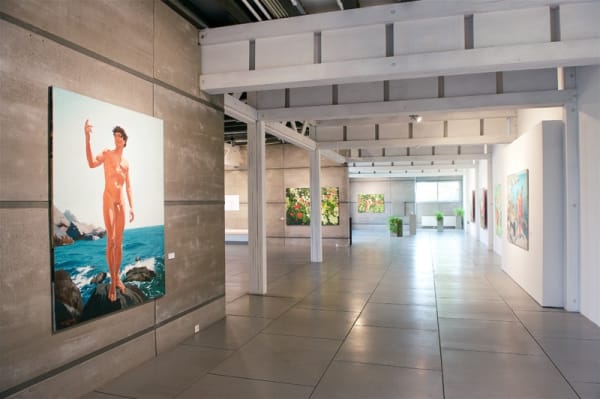Oleg Maslov. CONEFLOWERS AND ZINNIAS
This exhibition combines two periods of Oleg Maslov’s work. The earlier canvases are part of the “Blue Lagoon” series. They were painted some 23 years ago, at the dawn of Neo-Academism, a movement aimed at returning to the classics and to the traditional practices of the art, which was largely orchestrated by Timur Novikov in the late 1980s – early 1990s. The new works were painted by Oleg Maslov in 2015-2016.
In the halls of the New Academy in 1993, Oleg Maslov and Viktor Kuznetsov, working in creative tandem, created the first major Neo-Academistic cycle of large “Blue Lagoon” canvasses, eight of which – having travelled to the Netherlands, Denmark, Poland, Germany, Belgium, Italy, and Hungary – are currently being exhibited in Gridchinhall. The paintings are done in photographic style, and capture people on a summer outing on a nude beach in Simeiz. Among these is Lena Popova, who would soon become Russia’s first female DJ, Valeriy Katsuba, a soon-to-be famous photographer, and me. The naked figures in “Blue Lagoon” were given the names of ancient gods and heroes, and the paintings themselves are permeated with a bright light in a way that portrays that turbulent era as a time of lustrous bliss. The exhibition, which opened in the New Academy of Fine Arts in December 1993 and incidentally marked the opening of the New Academy at “Pushkinskaya 10” as well, was unusually popular. Visitors to the exhibition included Anatoliy Sobchak, Galina Starovoytova, French celebrity philosopher Jacques Derrida, eminent musician Sergey Kuryokhin (who most likely was making some fun of the New Academists, dressed in a toga and with a crown of laurels), and many other well-known individuals.
Neo-Academism originated among the “New Artists” – the new wavers of the 1980s, who oriented themselves towards popular culture (“We play pop music”, said Viktor Tsoy once, dumbfounding those listening). It carried the genes of pop art, which can clearly be felt in the nature of the early neoclassical works of Maslov and Kuznetsov. Maslov found in this a definition for himself, calling his works “entertainment painting”. After all of this, there seems nothing strange about Maslov moving on to flowers, creating an entire new series of six canvasses. What connects these two series, done almost a quarter century apart? Maslov’s later works are more contemplative and meditative, but in “Blue Lagoon”, and in his recent flower series, we see a view of the world as the paradise of the Garden of Eden, or Arcadia, where we find ourselves in harmony with nature, free of the spectre of danger, as in the mother’s womb. We doubt there is a better time of year for this exhibition than the merry month of May, or a better place than the Gridchinhall Garden in bloom, called by one critic “the center of art-optimism”.
Andrey Khlobystin, fine arts expert
Oleg Maslov was born in 1965. From 1980-1984 he studied in the K.A. Savitskiy Art School in Penza. He has been exhibiting since 1985. Maslov is a member of the “New Wild”, “New Artists”, and the “Friends of Mayakovsky Club” artistic associations. He is also one of the founders of and a professor in the painting department at the New Academy of Fine Arts. From 1993 to 2005, Maslov worked together with Viktor Kuznetsov. His work can be found in the collections of the State Russian Museum, State Tretyakov Gallery, the Stedelijk Museum (Amsterdam), the “Gasunie” concern (Netherlands), and in private collections across Russia and around the world. He lives and works in Saint Petersburg.













